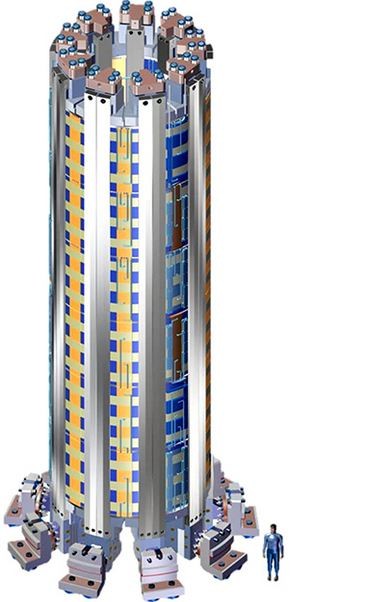A four-storey tall electromagnet currently being assembled at California could make possible the long-sought breakthrough that makes fusion energy a future power source that's non-polluting, reliable and cheap.
A fusion power plant could use only five kilograms of hydrogen to generate the energy equivalent of 18,750 tons of coal, 56,000 barrels of oil or 755 acres of solar panels.
General Atomics, a fusion energy firm based in California, recently began operations to fabricate the "ITER Central Solenoid," a 1,000 ton superconducting electromagnet designed to initiate and drive a hot plasma for fusion energy.
The company will fabricate seven modules, with six composing the central solenoid and one in reserve as a spare. Fabrication consists of 10 custom manufacturing stations for the superconducting magnet.
The International Thermonuclear Experimental Reactor (ITER) is an international nuclear fusion research megaproject to design and build the world's largest experimental "tokamak" fusion reactor.
The Central Solenoid will be the most powerful of its type in the world and will be used generate a magnetic field some 200,000 times greater than that of the Earth's. It's also the largest being built for a fusion reactor and is being fabricated at the General Atomics plant in Poway, California.
The Central Solenoid will be used in ITER experiments in France in which scientists will try to create a burning plasma that demonstrates the feasibility of fusion energy.
The ITER project is a large-scale scientific experiment intended to prove the viability of fusion as an energy source. It will also collect the data necessary for the design and subsequent operation of the first electricity-producing fusion power plant.
The project is expected to begin operations in 2019. Construction of the tokamak site in southern France began seven years ago.
ITER said fusion, the energy of the Sun and stars, will be available as a future energy option by the middle of this century.
The process is called fusion because energy is produced by fusing together light atoms such as hydrogen at the extremely high pressures and temperatures that exist at the center of the Sun (15 million ºCentigrade). At these high temperatures, any gas becomes plasma or the fourth state of matter.
To replicate this process on Earth, gases need to be heated to extremely high temperatures of about 150 million ºCentigrade at which atoms become completely ionized. The fusion reaction that is easiest to accomplish is the reaction between two hydrogen isotopes: deuterium, extracted from water and tritium, produced during the fusion reaction through contact with lithium.
When deuterium and tritium nuclei fuse, they form a helium nucleus, a neutron and massive amounts of energy.
In a tokamak, the plasma is held in a doughnut-shaped vessel. Using special coils, a magnetic field is generated that causes the plasma particles to run around in spirals, without touching the wall of the chamber.
ITER is the world's largest tokamak and is based on the tokamak concept of magnetic confinement.
Its fuel -- a mixture of deuterium and tritium, two isotopes of hydrogen -- is heated to temperatures in excess of 150 million °C, forming a hot plasma. Strong magnetic fields are used to keep the plasma away from the walls.
These magnetic fields are produced by superconducting coils surrounding the vessel, and by an electrical current driven through the plasma.
Clean fusion energy has been a holy grail for researchers looking for alternatives to nuclear energy and carbon-based fuels, both of which emit unacceptable and unsafe pollutants. Scientists say fusion energy does not create long-term radioactive waste products or carries meltdown risks.
Thirty five nations including the United States, the European Union, India, Japan and Korea are involved in the ITER project.



























